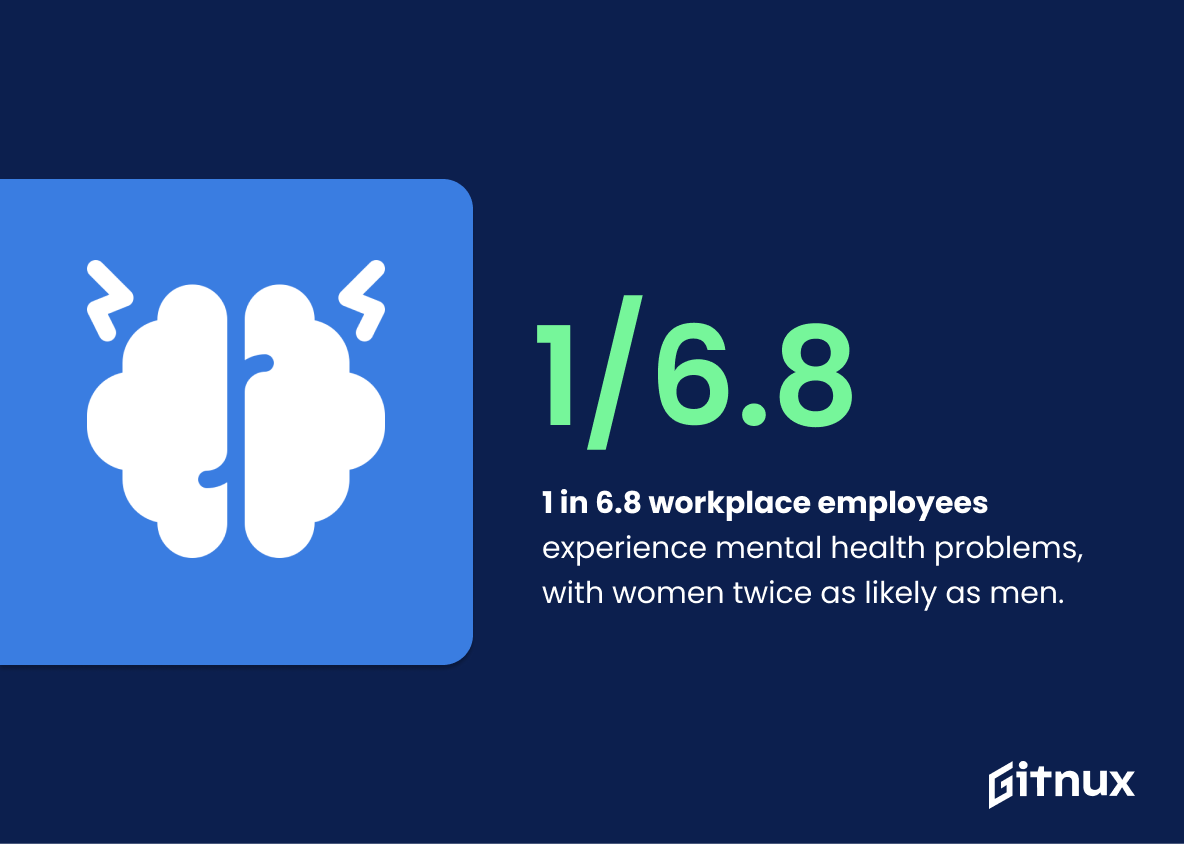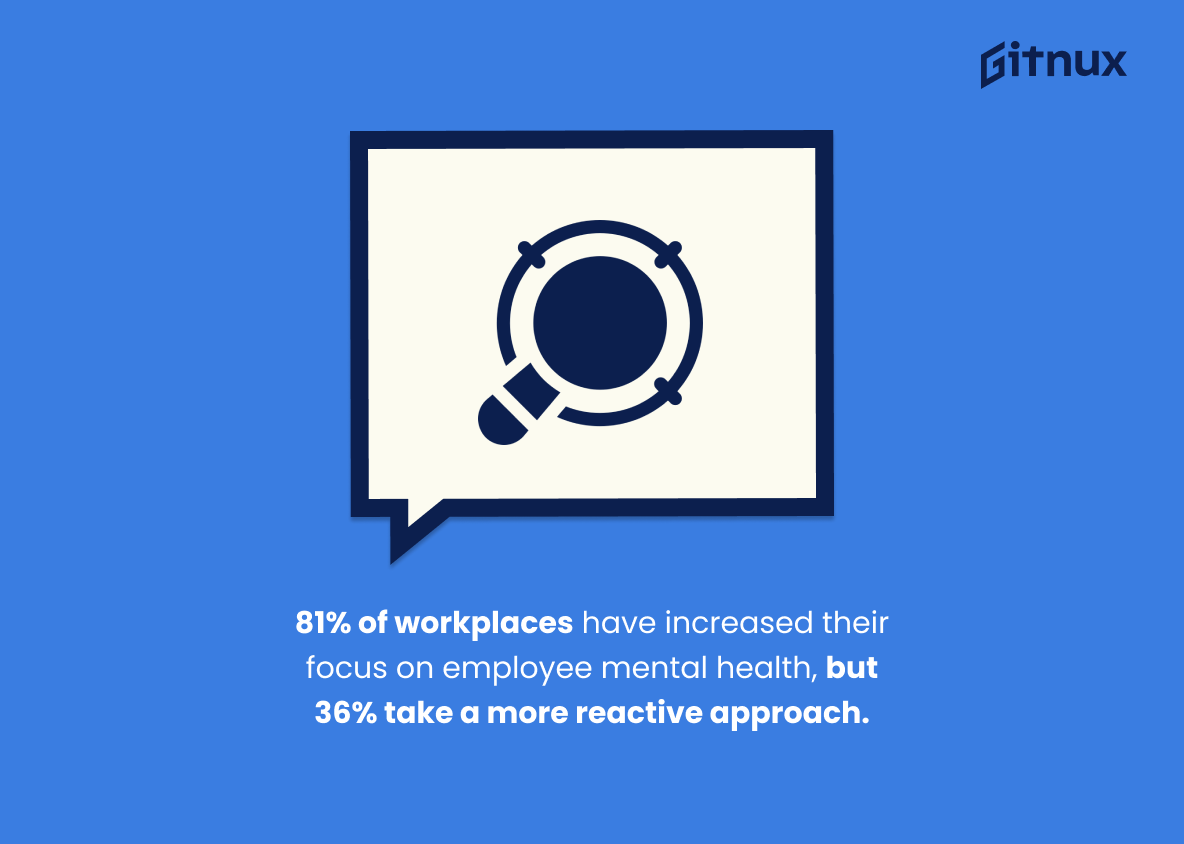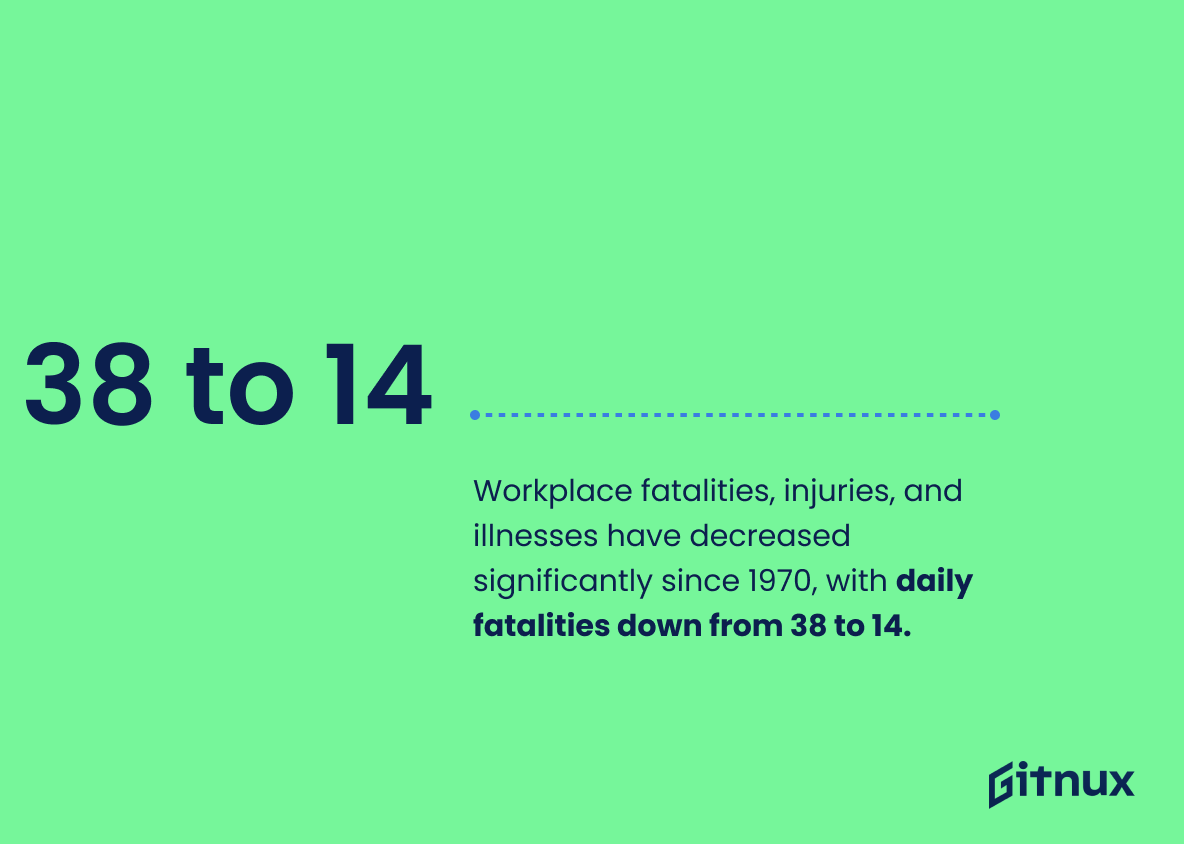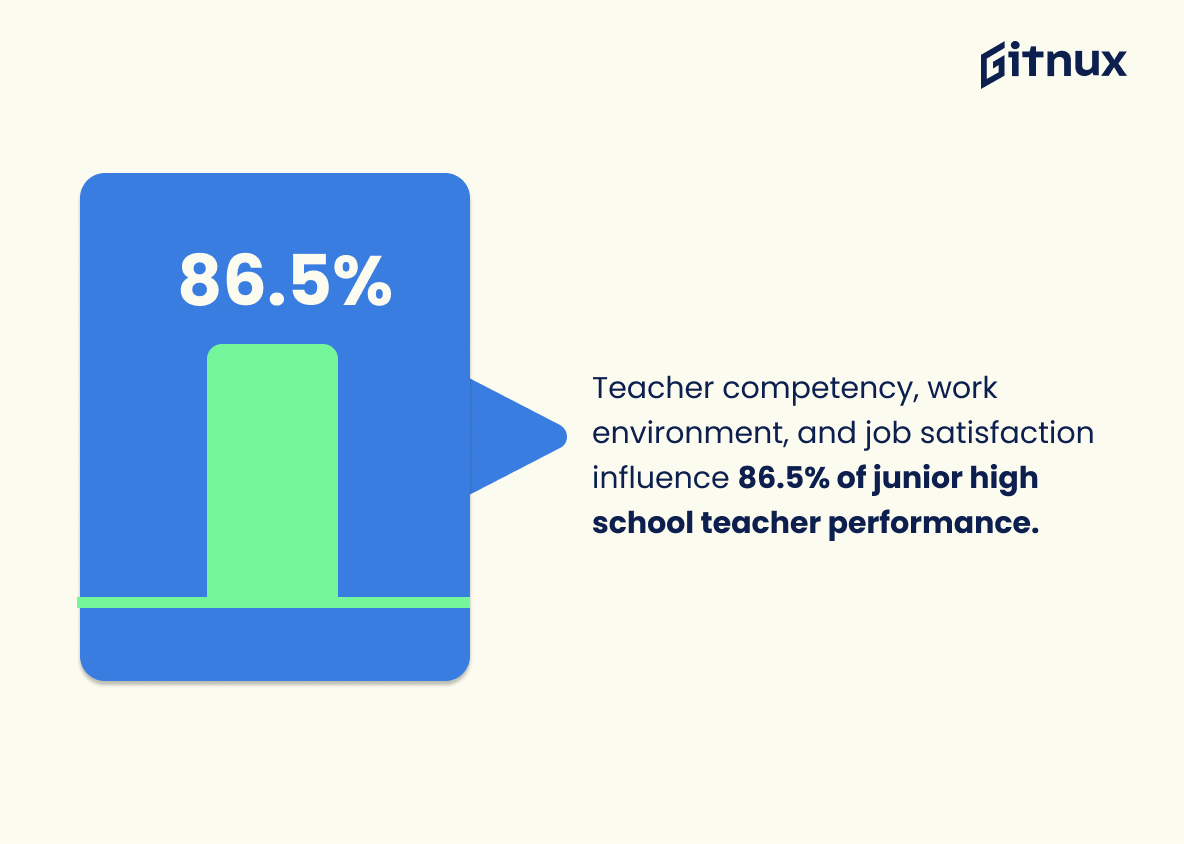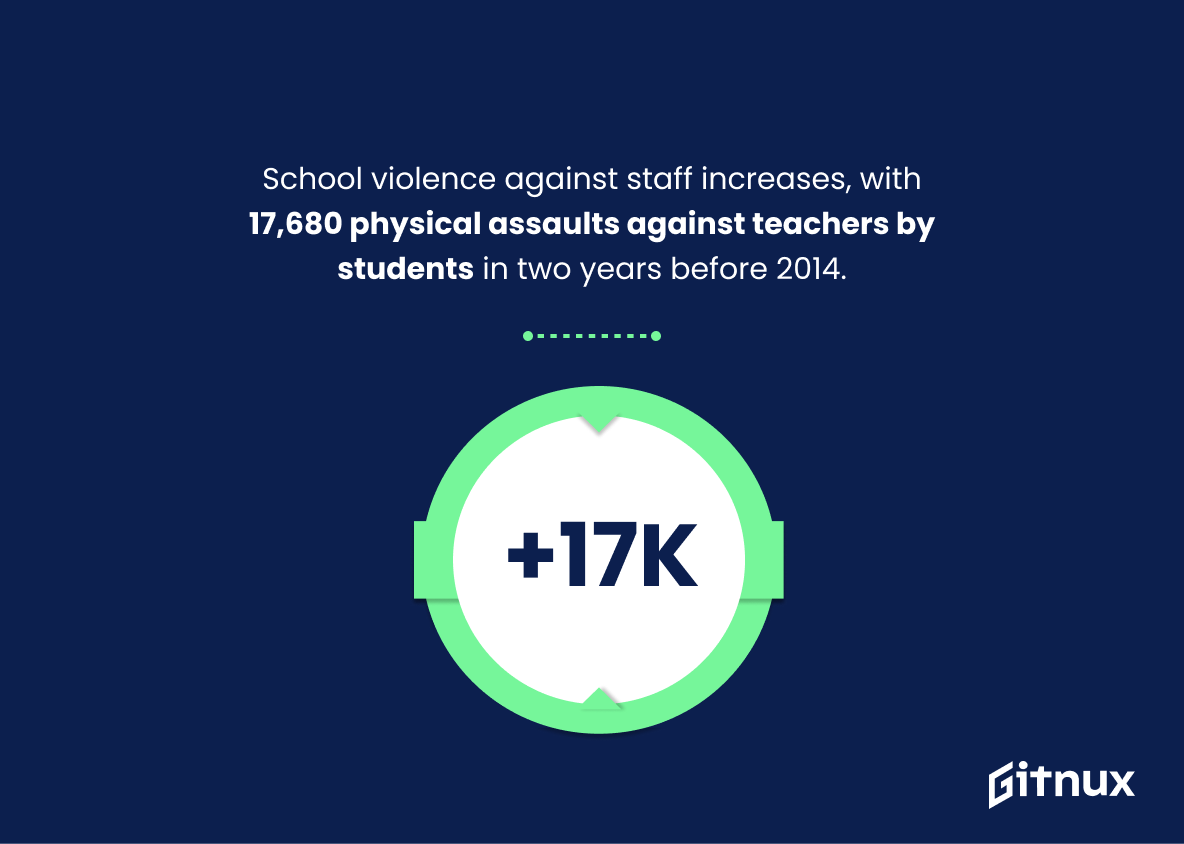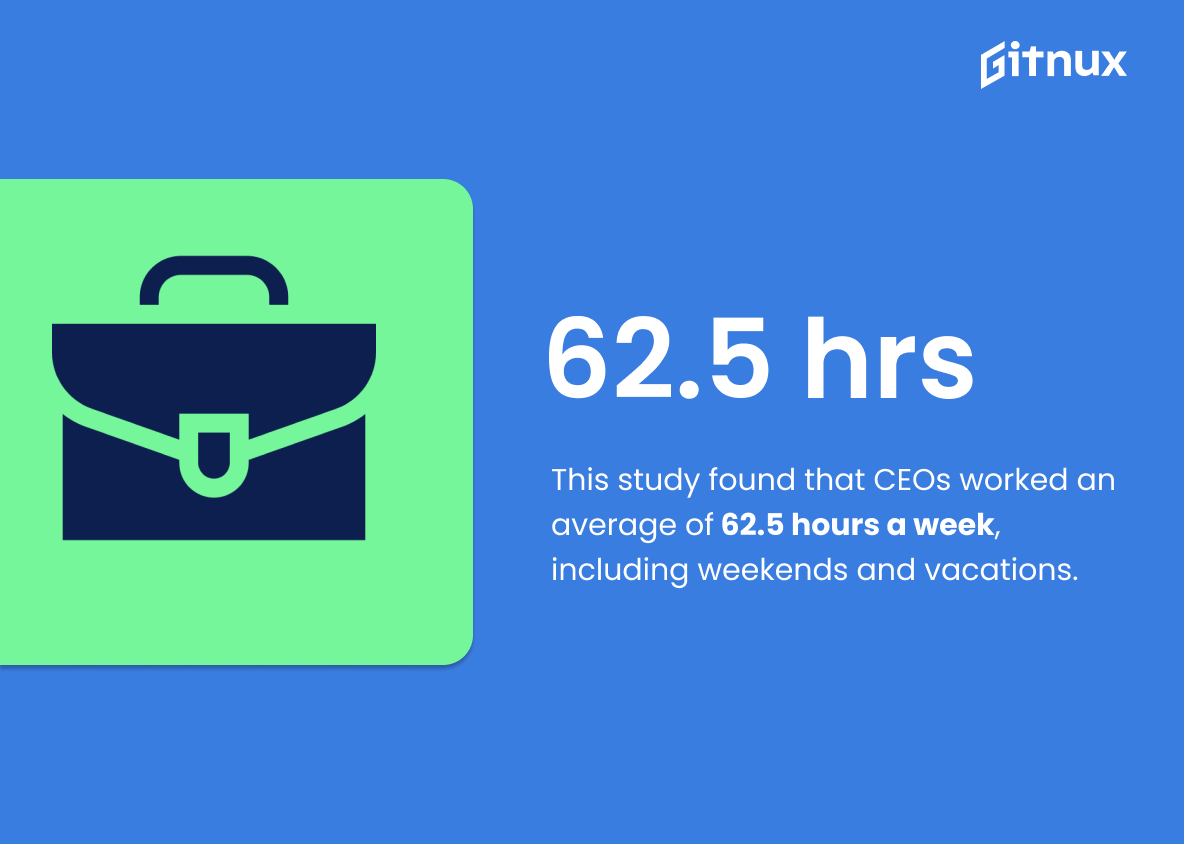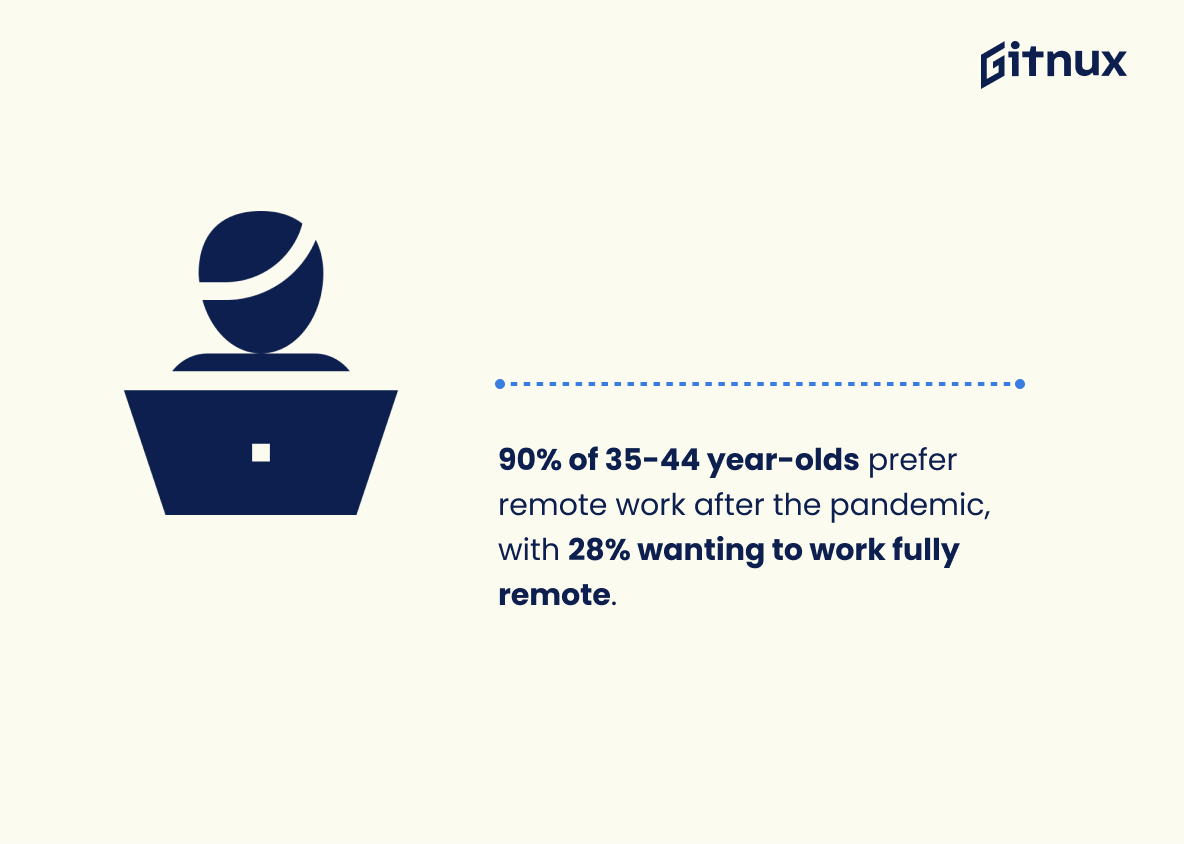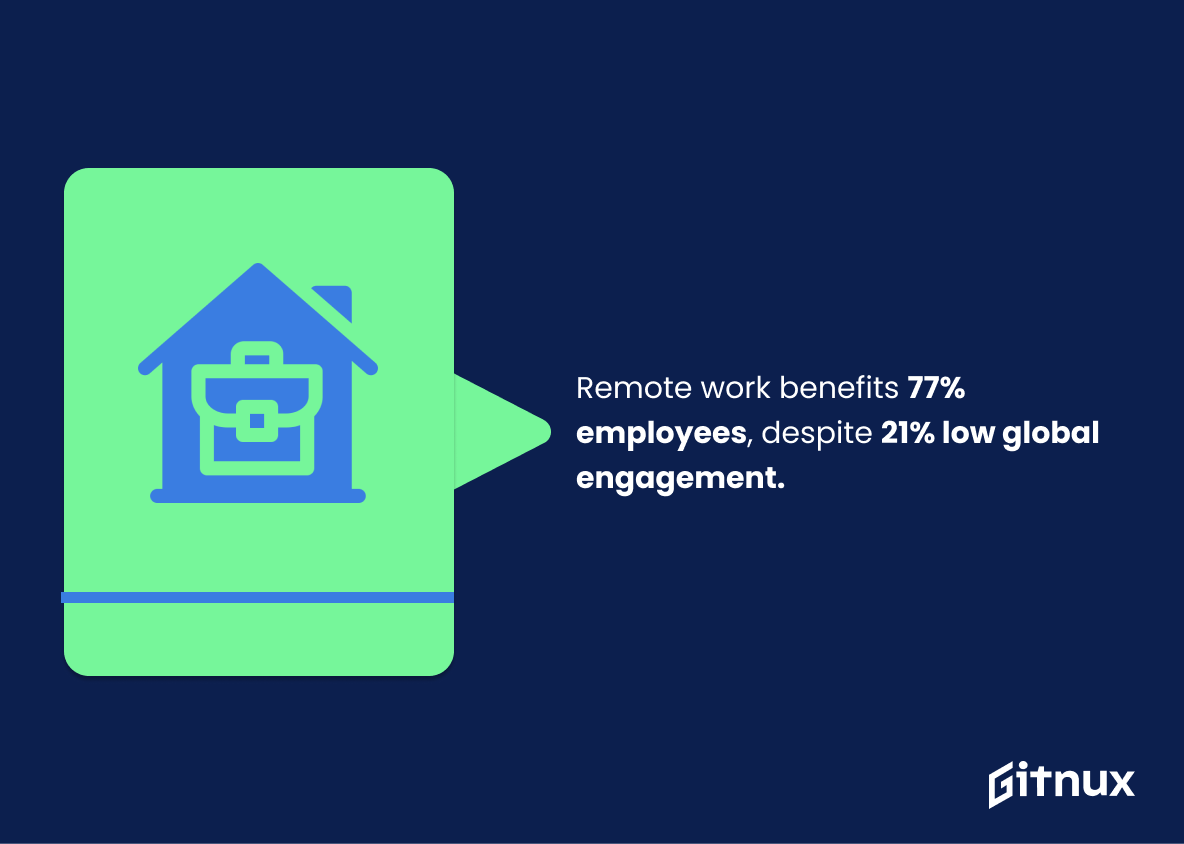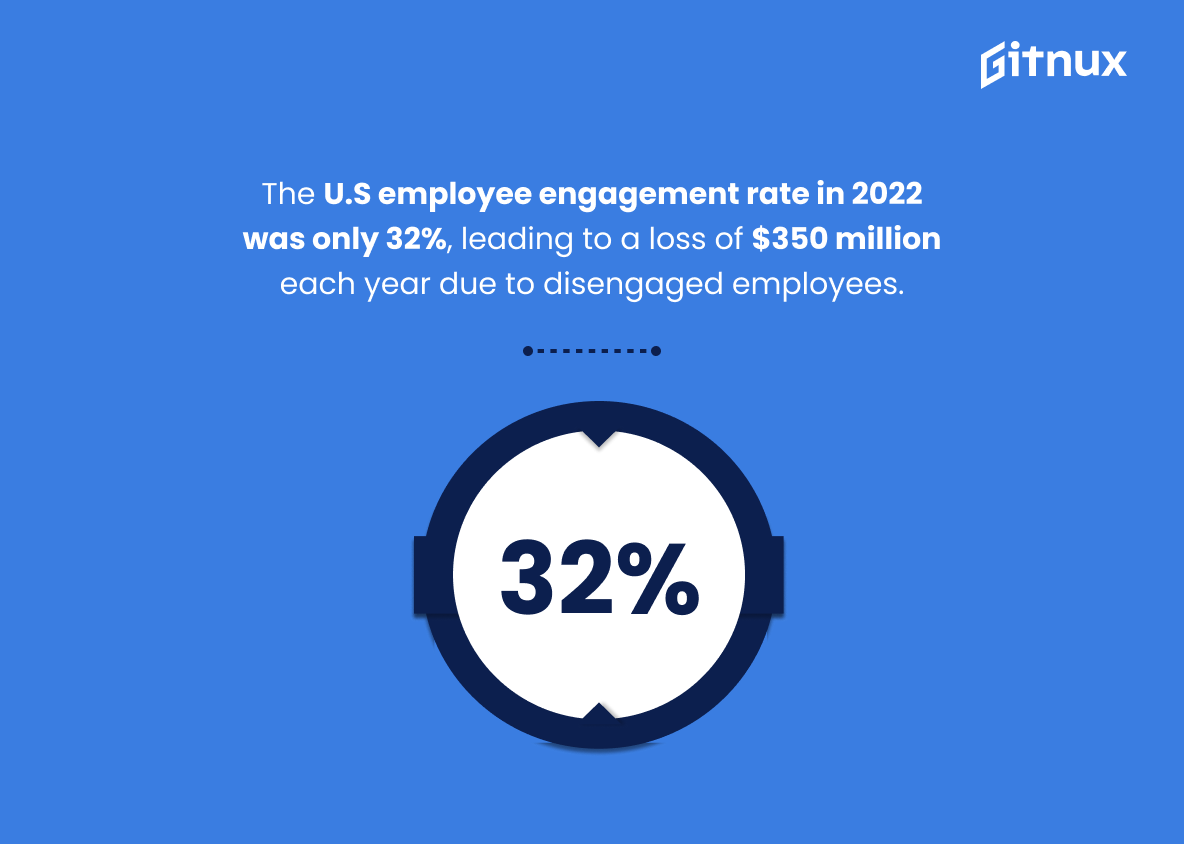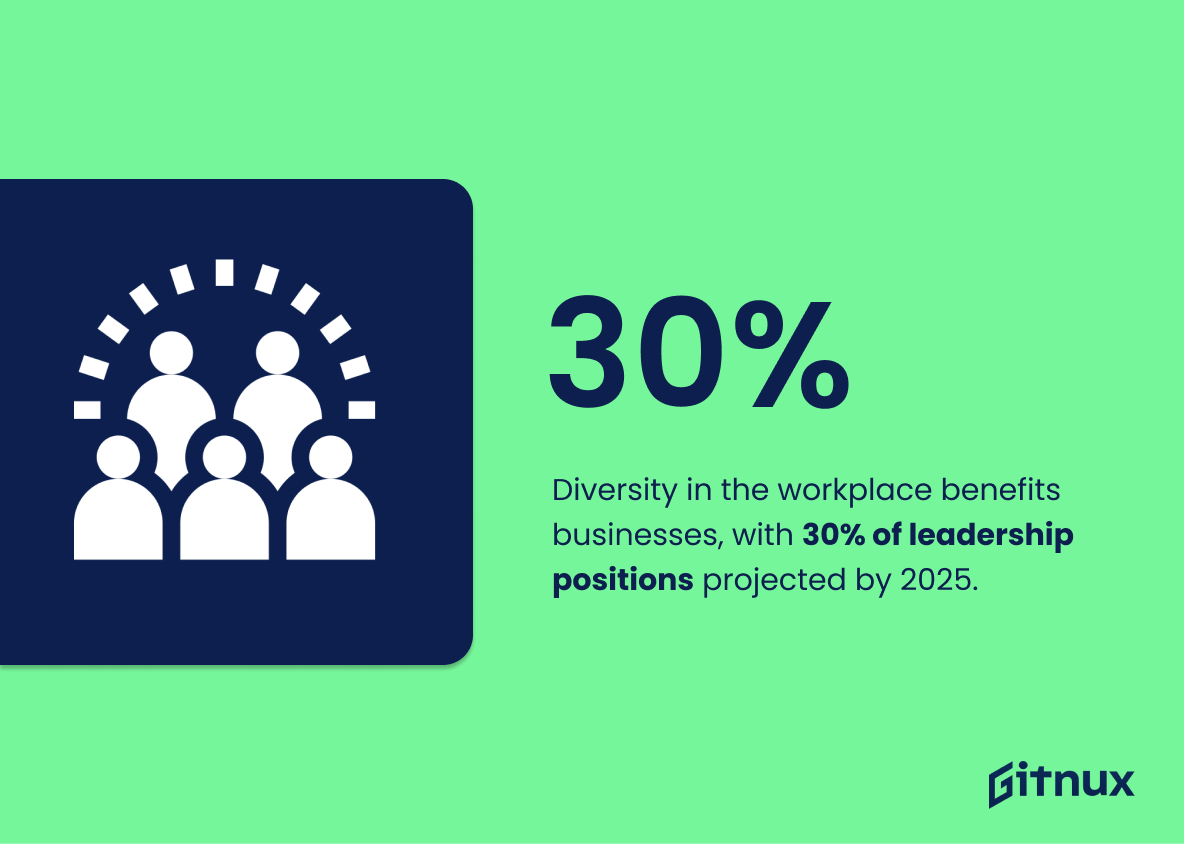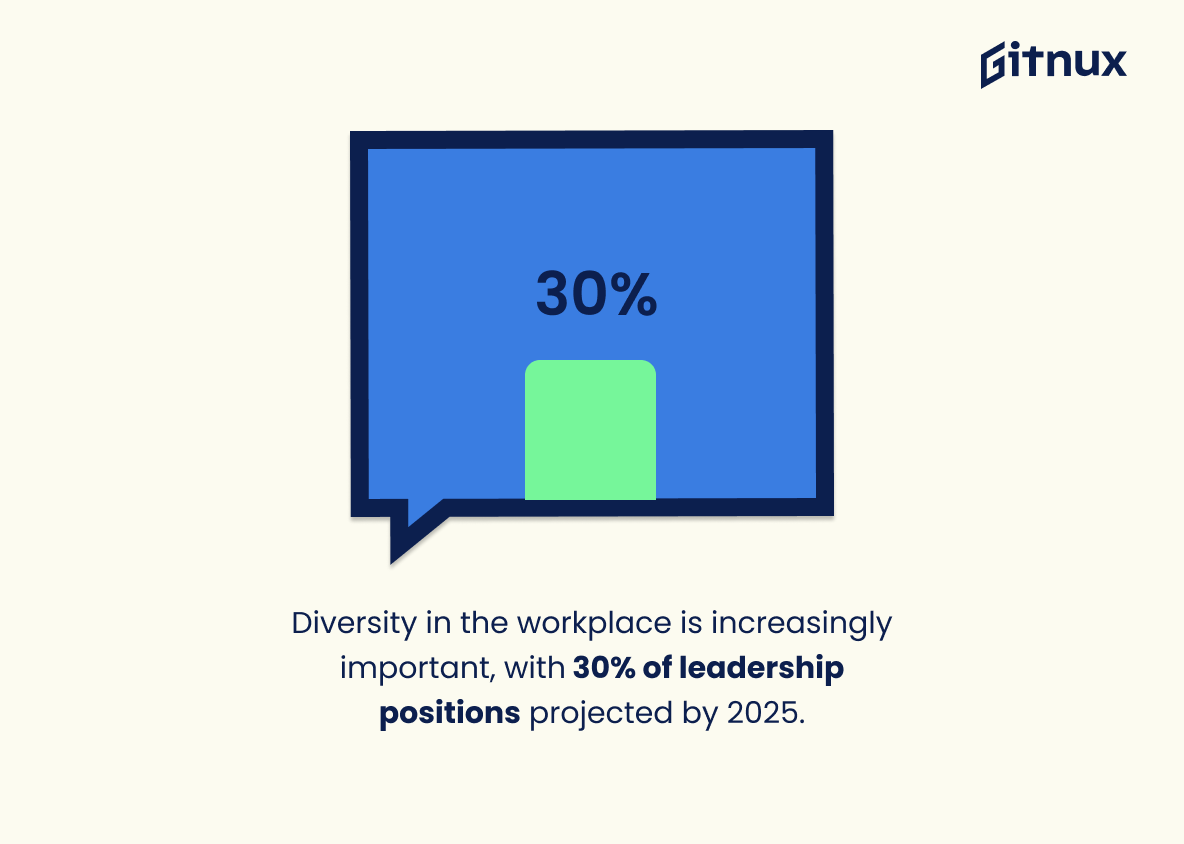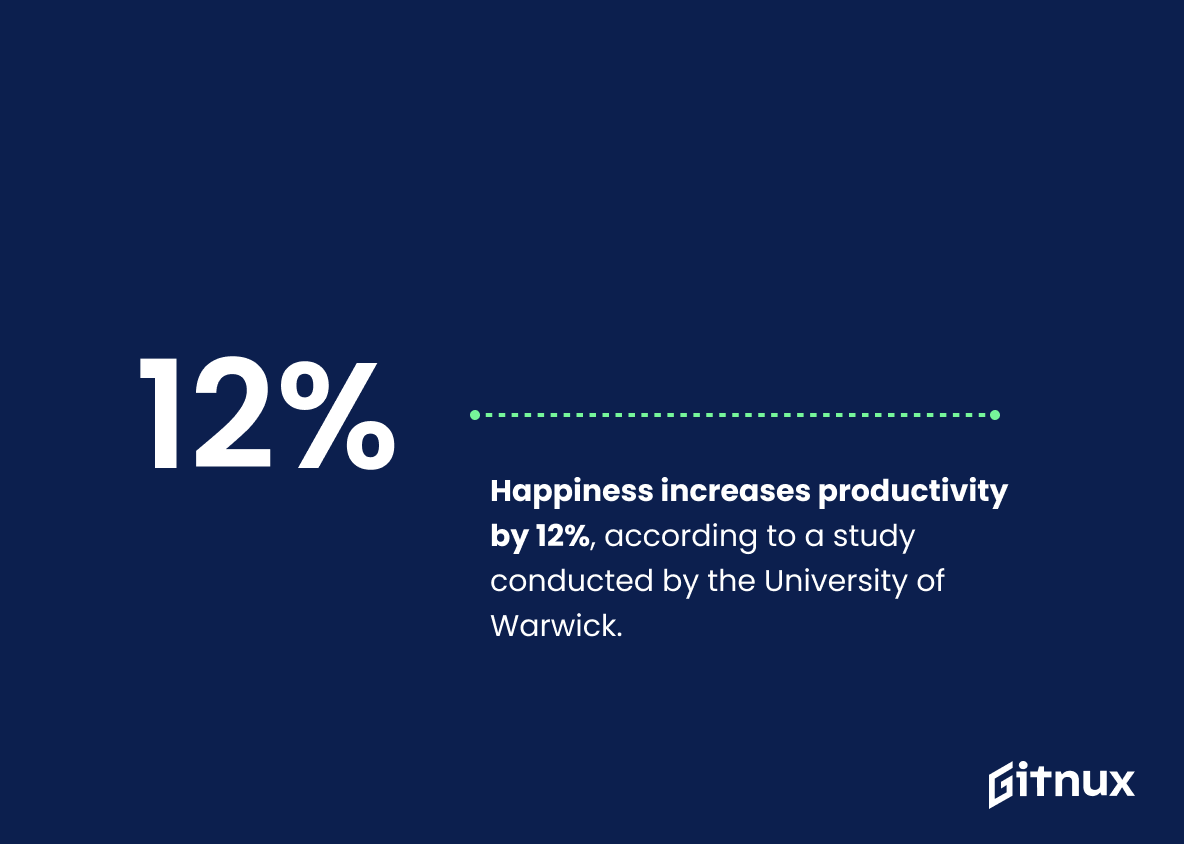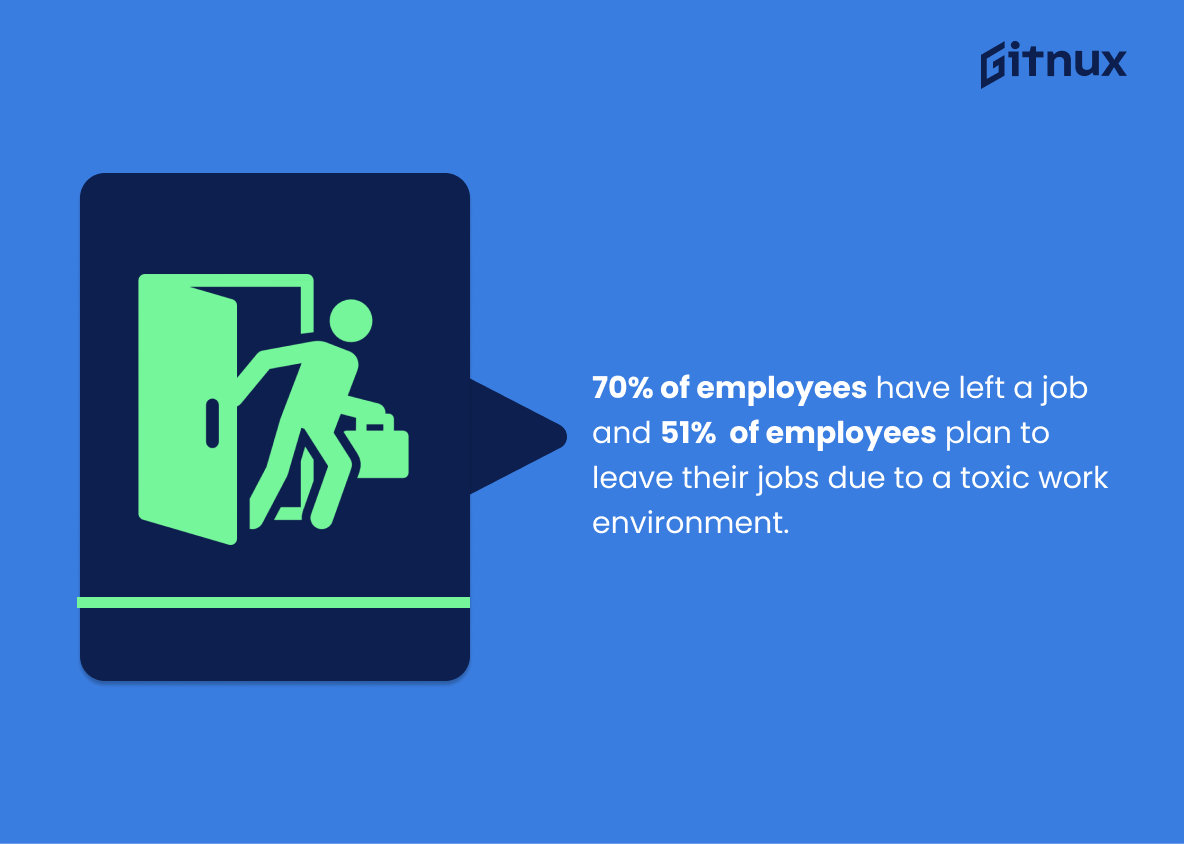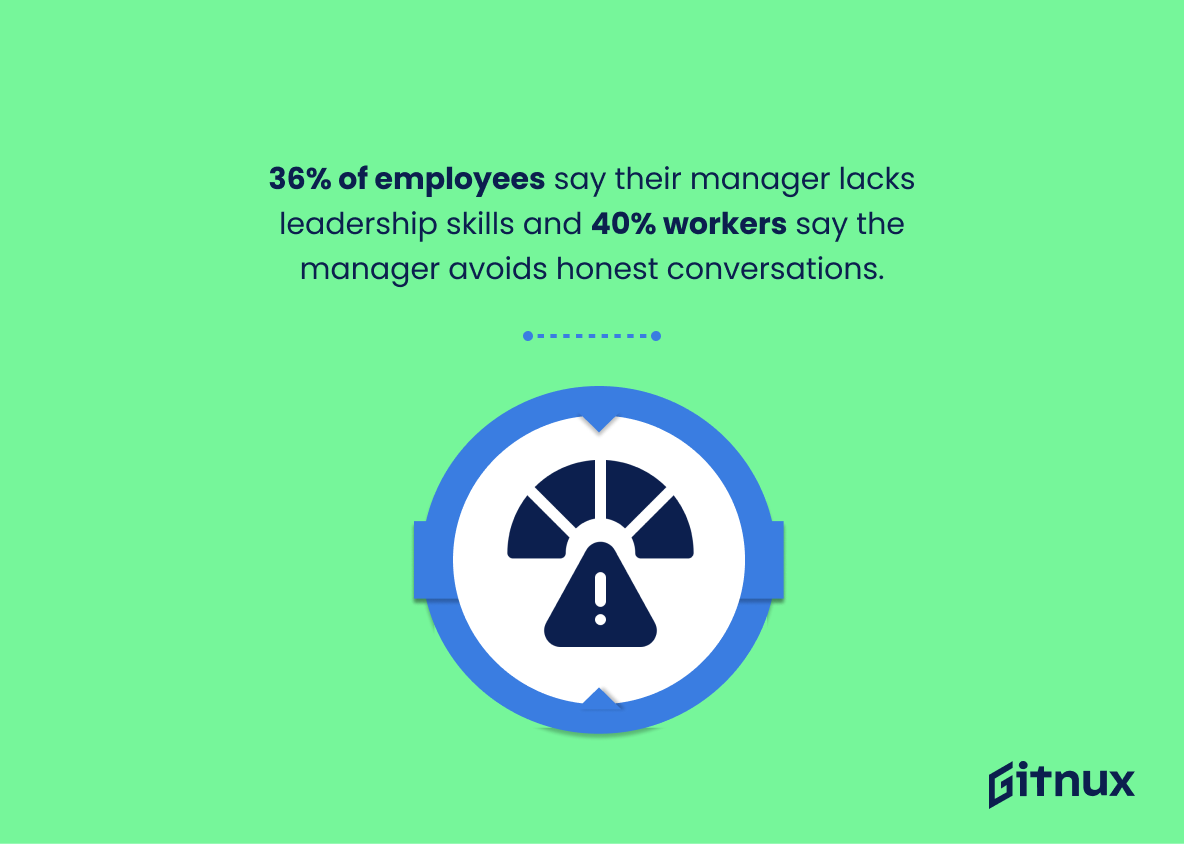The workplace is a major part of our lives, and it’s important to understand the environment we’re in. In this blog post, we’ll be looking at some of the key statistics about the work environment, including employee satisfaction, job security, and workplace diversity.
We’ll also explore how these statistics can help employers create a better work environment for their employees. Finally, we’ll discuss the implications of these statistics for businesses and their employees. So, let’s dive in and take a closer look at the work environment statistics.
Work Environment: The Most Important Statistics
80% of respondants showed a positive attitude to remote work, with over 60% considering switching their current positions for remote ones.
Happiness increases productivity by 12%, according to a study conducted by the University of Warwick.
Work Environment: Statistics Overview
1 in 6.8 people experience mental health problems in the workplace, and women are nearly twice as likely to have a common mental health problem as men.
This matters in the context of work environment statistics because mental health issues in the workplace can have a negative impact on employee engagement, productivity, and reputation, and can cost businesses up to £1652 per employee per year.
Promoting wellbeing at work through personalised information and advice, a risk-assessment questionairre, seminars, workshops, and web-based materials can save businesses up to £8 billion annually and cost approximately £80 per employee per year.
81% of workplaces have increased their focus on employee mental health, however 36% take a more reactive approach.
This matters in the context of Work Environment Statistics because it shows that while many organisations are taking action to support employee mental health, there is still a need for more proactive approaches to ensure a healthy work-life balance for employees. This is important as it can have a positive impact on employee morale and productivity.
Since 1970, workplace fatalities, injuries and illnesses have decreased significantly, from 38 daily fatalities to 14, and from 10.9 incidents per 100 workers to 2.8 incidents per 100 workers.
This matters in the context of Work Environment Statistics because it shows that organizations that commit to addressing environmental hazards in the workplace can create and maintain safe environments for their employees, which not only prevents injuries and illness but also reduces costs, improves productivity and increases employee morale.
Noise, thermal discomfort, and inadequate lighting are all potential hazards in the workplace that can cause serious health damage and should be addressed with preventive measures. This matters in the context of Work Environment Statistics because it highlights the importance of creating a safe and healthy work environment for employees.
If employers are aware of the potential risks associated with noise, thermal discomfort, and inadequate lighting, they can take steps to reduce the risk of harm to their employees.
This study found that teacher competency, work environment and job satisfaction have an influence of 86.5% on the performance of junior high school teachers.
This is important as it shows that a positive work environment can have a significant impact on the performance of teachers.
Violence in schools against staff is a growing problem, with 17,680 recorded cases of physical assaults against teachers by students in the two years before 2014.
This statistic matters in the context of work environment statistics because it highlights the need for improved safety measures in schools to protect both teachers and students. It also emphasizes the importance of providing teachers with regular breaks, discreet alarms, staff meetings, and checklists to help manage the difficult task of school safety.
Give feedback to employees that they will listen to, have frequent one-on-ones, and be specific with feedback. This matters in the context of work environment statistics because it shows that managers are often uncomfortable communicating with employees and giving feedback.
If managers don’t learn how to give feedback that employees will actually listen to, then it can create a negative work environment and lead to decreased productivity.
The quality of management throughout a business hierarchy is essential for employee engagement, safety, and long-term continuity.
This matters in the context of Work Environment Statistics because it highlights the importance of having effective management teams in place to ensure that employees feel valued and motivated, and that the working environment is safe and productive. Without this, operations are likely to be affected, and long term continuity will be in danger.
This study found that CEOs worked an average of 62.5 hours a week, including weekends and vacations.
This matters because it shows the dedication and hard work that is expected of those in executive positions, and provides insight into the work environment of those at the top of the corporate ladder.
The study of how CEOs of large, complex organizations spend their time reveals the many components and dimensions of leadership and the challenges of the role.
This matters in the context of Work Environment Statistics because the success of CEOs has a direct impact on employees, customers, communities, and wealth creation.
80% of respondants showed a positive attitude to remote work, with over 60% considering switching their current positions for remote ones – this demonstrates the potential of a hybrid work model to improve employee productivity.
This statistic matters in the context of Work Environment Statistics because it shows the potential of remote work to improve employee productivity, which can be beneficial for both employers and employees. It also highlights the importance of considering a hybrid work model when designing work environments.
9 in 10 of those between 35-44 prefer to continue working remotely when pandemic restrictions end, and 28% would rather work remotely all the time.
This statistic matters in the context of Work Environment Statistics because it shows that remote work is a desirable option for many employees, and it has allowed for higher productivity due to a better work-life balance.
The Statista survey indicates that flexible scheduling is the most desired benefit of remote work for employees in developed countries. This is important as it shows that employees in these countries are looking for more flexibility in their work environment, which could lead to improved productivity and job satisfaction.
77% of remote workers experience better productivity, 88% are happier, and have reduced stress and improved mental health – this matters in the context of Work Environment Statistics because it shows that remote work can be beneficial for employees in terms of productivity, happiness, and mental health. Only 21% of employees worldwide are engaged in the workplace, with an increasing rate of actively disengaged employees, which can be costly to businesses.
This statistic matters in the context of Work Environment Statistics because it highlights the importance of employee engagement for the success of a business.
When employees are engaged in their work, they are more productive and this leads to higher profitability. Therefore, it is important for businesses to ensure that their employees are engaged in their work in order to maximize their success.
The U.S employee engagement rate in 2022 was only 32%, leading to a loss of $350 million each year due to disengaged employees.
This statistic is important in the context of Work Environment Statistics because it highlights the importance of employee engagement in the workplace.
Companies with engaged employees are more likely to have higher productivity and lower costs, which can lead to increased profits and a better market performance. Additionally, it highlights the financial cost of disengaged employees, which can be a major burden on the economy.
Positive company culture is essential for success in business, as it is highly valued by both executives and employees, leading to increased productivity, better engagement, and higher profitability. This statistic is important in the context of Work Environment Statistics because it shows that recognition and appreciation in the workplace is key for employee retention and job satisfaction.
It also highlights that job seekers consider company culture as an important factor in the job application process, and that satisfied employees are more productive in the workplace. This demonstrates the importance of creating a positive company culture in order to increase productivity, engagement, and profitability.
Company culture has a significant impact on employee engagement and job satisfaction, with 89% of highly engaged employees having a positive work culture. This statistic is important because it shows that a positive work culture is essential for a successful business. It can promote employee engagement, retention, and performance through transparency, recognition, and rewards.
Additionally, it shows that job seekers prioritize company culture when making job search decisions. Therefore, it is important for businesses to focus on creating a positive work culture in order to attract and retain employees.
Diversity in the workplace leads to increased profits, competitiveness, productivity, and a positive public image, and is projected to hold 30% of leadership positions by 2025.
This matters in the context of work environment statistics because it highlights the importance of diversity in the workplace. By having a diverse workforce, companies can benefit from increased profits, improved services, and a better public image.
Additionally, it shows that diversity is becoming increasingly important in the workplace, as it is projected to hold 30% of leadership positions by 2025. This can help companies to better understand the importance of diversity and inclusion in the workplace and how it can benefit them.
The COVID-19 pandemic has further widened the already unequal work equity gaps, with women, Black and Hispanic Americans being more likely to experience job and wage loss than white Americans. This statistic is important in the context of Work Environment Statistics because it highlights the unequal access to good jobs and the need for companies to promote equality and diversity through education initiatives.
This can benefit the company in many ways, such as increased sales revenue and employee engagement, higher profits, and increased social mobility.
Companies with a strong culture are associated with increased productivity, better employee engagement, and higher profitability. This statistic is important because it shows the tangible benefits of having a positive work environment.
It demonstrates that having a strong company culture is essential for a prosperous business, as it is associated with increased productivity, better employee engagement, and higher profitability. Furthermore, it shows that even something as simple as receiving a “Best Place to Work” award can have a positive impact on a company’s stock price.
Happiness increases productivity by 12%, according to a study conducted by the University of Warwick.
This matters because it shows that creating a positive work environment can lead to increased productivity, which can benefit the company as a whole.
72% of employees have left a job due to a toxic work environment, and 51% of employees plan to leave their current job due to a toxic work environment.
This statistic matters because it shows that toxic work environments are a major issue across all industries, and that they have a huge impact on employee retention. This highlights the importance of creating a positive work environment in order to retain employees and ensure the success of the business.
36% of employees say their manager doesn’t know how to lead a team, and 40% say their manager fails to engage in honest conversations about work topics.
This statistic is important in the context of work environment statistics because it highlights the need for managers to be trained on creating a positive work environment and establishing a culture of respect and dignity. Without this training, managers can unknowingly facilitate toxic work environments, which can have a negative impact on employee morale and productivity.
The outbreak of coronavirus (COVID-19) pandemic in 2020 has led to an increase in the hybrid work model, which has been proven by strong sales growth of hardware devices such as PCs, notebooks, and headphones.
This statistic is important because it shows how businesses have had to quickly adapt to the changing work environment due to the pandemic, and how technology is playing an increasingly important role in enabling employees to work safely from remote locations. It also highlights the need for proper collaboration tools to support these hybrid work models in order to create an effective work environment.
61% of full-time flex work office employees in Australia reported that their team was working effectively under the hybrid work model in 2021.
This statistic is important because it shows that the hybrid work model is effective in Australia, which could be beneficial for other countries looking to implement a similar model. It also demonstrates that the hybrid work model is more effective in Australia than in Japan, which could be useful for further research into why this is the case.
Companies that promote diversity and inclusion have higher profits, increased employee engagement, and more innovation. This statistic is important because it shows that companies that promote diversity and inclusion in their work environment benefit in many ways. This includes higher profits, increased employee engagement, and more innovation.
This is beneficial for both the company and its employees, as it creates a more positive work environment and encourages creativity and collaboration. Additionally, it can lead to increased social mobility and higher sales revenue. All of these factors are important for any company to consider when looking to create a successful and productive work environment.
Companies that are gender and ethnically diverse are more likely to experience growth and outperform their competitors, with research showing that gender-diverse companies are 15% more likely to outperform their peers and ethnically-diverse companies are 35% more likely to do the same.
This matters in the context of work environment statistics because it shows that diversity is a key factor in success and should be prioritized in the workplace.
The Institute for Employment Studies Report shows that workplace counselling is highly effective and beneficial for individual employee issues, with 90% of clients surveyed reporting satisfaction with the counselling received.
This matters in the context of Work Environment Statistics because it highlights the importance of having a healthy workforce for improved organisations, individual and societal outcomes. It also shows that workplace counselling is an effective intervention that can help improve mental health of employees.
69% of surveyed employees agreed it was safer not to share workplace concerns with their employer.
This statistic is important because it highlights the need for employers to provide mental health services in the workplace. By providing these services, employers can create a safe and supportive environment for their employees, which can lead to increased productivity and a more positive work culture.
Conclusion
In conclusion, the statistics surrounding work environment are incredibly important to consider when assessing the overall health of a workplace. By understanding the data, employers can make informed decisions that will improve the work environment and increase employee satisfaction.
Additionally, employees can use the data to understand their rights and make sure they are being treated fairly. Ultimately, the data surrounding work environment can be used to ensure that everyone is working in a safe and productive environment.
References
1 – https://www.mentalhealth.org.uk/explore-mental-health/mental-health-statistics/mental-health-work-statistics#:~:text=1%20in%206.8%20people%20experience,in%20the%20workplace%20(14.7%25).&text=Women%20in%20full%2Dtime%20employment,(19.8%25%20vs%2010.9%25).
2 – https://mhfaengland.org/mhfa-centre/blog/10-workplace-mental-health-statistics-2022/
3 – https://safetymanagement.eku.edu/blog/environmental-hazards-in-the-workplace/
4 – https://www.who.int/tools/occupational-hazards-in-health-sector/risks-in-ambient-work-environment
5 – https://www.researchgate.net/publication/335981436_The_Effect_of_Teachers_Work_Environment_and_Work_Satisfaction_on_the_Performance_of_IPS_Teachers_of_the_Demak_Regency
6 – https://www.anttelecom.co.uk/blog/workplace-teacher-safety
7 – https://officevibe.com/blog/shocking-statistics-manager-needs-know
8 – https://mdatraining.com/blog/4-statistics-on-management-development-in-the-workplace/
9 – https://www.cnbc.com/2018/06/20/harvard-study-what-ceos-do-all-day.html
10 – https://hbr.org/2018/07/how-ceos-manage-time
11 – Attitudes on remote work for employees worldwide from 2020 to 2021, by category
12 – Press Statement Pulse Survey Our Lives Online: Remote Work November 2021
13 – Benefits of working remote in 2020, by country
14 – The Ultimate List of Remote Work Statistics in 2022
15 – 12 Employee Engagement Statistics You Need To Know In 2023
16 – Employee Engagement Statistics That Matter in 2022
17 – Company Culture Statistics: Leadership and Engagement in 2022
18 – 16+ Key Company Culture Statistics for 2023
19 – The Importance of Diversity in the Workplace – 20 Key Statistics
20 – Diversity in the workplace statistics you need to know in 2023
21 – https://teamstage.io/company-culture-statistics/
22 – https://warwick.ac.uk/newsandevents/pressreleases/new_study_shows/#:~:text=Happiness%20makes%20people%20more%20productive,people%20around%2012%25%20more%20productive.
23 – https://www.careerplug.com/blog/toxic-work-environment/
24 – https://civilitypartners.com/some-shocking-stats-about-toxic-work-cultures/
25 – https://www.statista.com/topics/7560/hybrid-work/#topicOverview
26 – https://www.statista.com/statistics/1326715/office-employees-hybrid-work-effectiveness/
27 – https://www.instride.com/insights/workplace-diversity-and-inclusion-statistics/
28 – https://joshbersin.com/2015/12/why-diversity-and-inclusion-will-be-a-top-priority-for-2016/
29 – https://www.employment-studies.co.uk/system/files/resources/files/553.pdf
30 – https://www.choosingtherapy.com/mental-health-in-the-workplace/
ZipDo, cited June 2023: Work Environment Statistics
